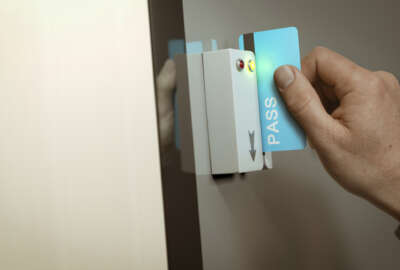
Agencies making push for identity authentication changes
To better cybersecurity, government agencies are starting the change the way they authenticate identities.
The impetus to change the way government employees’ identity is authenticated when logging onto computers and entering buildings is gaining more steam.
The Homeland Security Department is beginning a pilot program to test mobile-derived credentials for federal workers.
But that’s not the only advancement in government identity management. The Defense Department is making strides in its push to make Common Access Cards extinct over the next two years as well.
DHS’ derived credentials pilot will go into a user acceptance test in a few weeks, Tom McCarty, director of Identity, Credential and Access Management’s Program Management Office at DHS told Federal News Radio after an Aug. 24 speech at an FCW Security Summit event in Washington.
The program is built around DHS’ standardized government issue identity cards.
“We have focused on building a capability to be ultimately agnostic to all the different devices and operating systems that will come in the future, but we had to start someplace. … We have built off of the infrastructure we have,” McCarty said.
The pilot will start with Apple iOS devices and use VMware’s AirWatch for its mobile device management.
“We were more interested in making sure the process is secure and expandable,” McCarty said. “We are going to do a 50 user pilot that involves multiple agencies and then we are going to see where we are. Our hope is that the pilot is a success and it will be able to replace some of our legacy devices with credential derived iOS-enabled devices.”
As DHS pivots its ID management system, DoD is trying to make good on its pledge to rid the Pentagon of the CAC card it’s used for the past 15 years.
Marianne Bailey, DoD’s principal director, deputy chief information officer for cybersecurity said she felt confident the CAC phase out will continue into the next presidential administration.
DoD Chief Information Officer Terry Halvorsen is leading the charge to kick the CAC to the curb.
“Anybody that knows Terry Halvorsen knows he challenges us all the time, which is an awesome thing because it keeps us moving forward. … We’re looking at everything that’s out there. We had a team go and spend time at the [Defense Innovation Unit Experimental] out in Silicon Valley. We had a team out there for two weeks looking at everything that’s going on, they can get their hands on what’s coming up in Silicon Valley, what are the cool things, the new things people are doing,” Bailey said.
The Defense Manpower Data Center said it issued 2.8 million CAC cards last year to uniformed service members, civilian employees and contractors.
Over the last 15 years, DoD has issued more than 20 million CAC cards.
DoD has struggled over the last decade to find the best way to integrate the smart identity cards with mobile devices.
DoD wants to move completely away from cards and focus more on the biometrics side of identity.
“There’s so many things gathering information about us as individuals, the way we walk, the way we hold our phone, the way we do all kinds of things. So why can’t you use the things you know about me [for identity]. Maybe you have 50 things that you’re tracking on me as a person. Just randomly pick five of them that you are going to use,” Bailey said.
She added DoD has not made any solid decisions yet, but is keeping its options open.
Copyright © 2025 Federal News Network. All rights reserved. This website is not intended for users located within the European Economic Area.
Scott Maucione is a defense reporter for Federal News Network and reports on human capital, workforce and the Defense Department at-large.
Follow @smaucioneWFED




